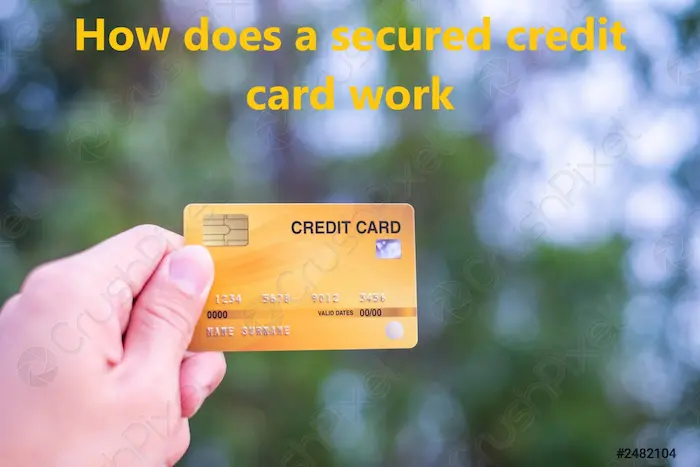What is a Secured Credit Card?
A secured credit card is designed for people with poor credit or a very limited credit history. The goal of a secured credit card is to help you build credit over time. They will require a refundable deposit, and generally, that refundable deposit is your credit limit. So essentially, you’re exchanging money today for a credit limit and the opportunity to build credit over time.
Let’s say you give the issuer $300; then your credit limit is often around $300. The goal again is to help you systematically build credit over time and to not get over your skis beyond your credit limit, limiting the downsides for the card issuer. Often after you pay your bill on time for several months, build trust, and build credit, you can call up the bank or issuer and ask them to increase your credit limit, which sometimes happens.
How Does a Secured Credit Card Work?
The simple answer is that a secured credit card requires a refundable deposit upfront, whereas an unsecured credit card does not. Some card issuers specialize only in secured credit cards, while others offer both secured and unsecured credit cards. There may be an advantage to choosing an issuer that offers both because down the road, there is the option to product change your secured credit card for an unsecured one. This can save you from needing to open a new credit card, which may affect your credit in the short term.
In theory, many issuers will allow you to upgrade your secured credit card to an unsecured credit card, but it depends on your circumstances. If I were looking for a secured credit card, I’d look for the option to upgrade later because unsecured credit cards often come with better rewards and a higher credit limit.
Annual Fees
It’s common for secured credit cards to charge a modest annual fee, typically between $30 to $50. However, some issuers do not charge annual fees, so this is another consideration when choosing a card.
Alternatives to Build Credit
If you don’t want to use a secured credit card, there are other ways to build credit. One option is to be added as an authorized user on a friend or family member’s credit card. The advantage here is a quicker approval process, and you’re piggybacking off their credit. However, if you default, it will show up on their credit, so you should only do this with someone you trust.
Another option for people with fair credit (anywhere between 580 and 670) is to apply for a retail credit card. These cards generally have lower approval thresholds but may come with higher interest rates and more specific rewards. As long as you pay off your balance every month, you don’t have to worry about interest rates.
How to Use a Secured Credit Card With a $200 Limit
Make Full and Timely Payments or Maintain a Minimum Balance
Start by always paying your credit card bill on time and in full. Timely payments are essential to establishing a positive payment history, especially with a $200 limit. If paying in full isn’t possible, aim to pay more than the minimum to reduce interest costs. Consider setting up reminders or automatic payments to avoid missing due dates.
Keep Your Credit Utilization Ratio Low
Try to keep your credit utilization ratio below 20%. For a $200 limit, this means keeping your monthly balance under $40. A low credit utilization ratio demonstrates responsible credit management and positively impacts your credit score.
Monitor Your Spending
Track your spending to ensure you stay within the $200 limit. Regularly review your transactions to catch errors and prevent unauthorized charges.
Live Within Your Means
To maintain your $200 threshold, live within your means. Only use the card for what you can afford to repay, and avoid maxing it out. Responsible spending helps you avoid debt and protect your credit score.
3 Secured Credit Cards to Start Building Credit
1. Amazon Secured Credit Card
If you frequently shop on Amazon, the Amazon Secured Credit Card is a great choice for building credit. Here’s why:
- No fees: No annual fees to worry about.
- Deposit: The minimum security deposit is $100, and the maximum is $11,000.
- Cashback: Earn 2% cash back on Amazon purchases if you have an Amazon Prime membership.
- Credit bureau reporting: It reports to all three major credit bureaus.
- Approval: Even those with bad credit often get approved.
- Late fee: The maximum late fee is only $5.
- APR: The card has a 10% APR, which is reasonable.
The downside? It can only be used for Amazon purchases.
2. Bank of America Unlimited Cash Rewards Secured Credit Card
The Bank of America Unlimited Cash Rewards Secured Credit Card offers the following:
- No annual fees: Completely free to maintain.
- Unlimited cashback: 1.5% cashback on every purchase.
- Cashback options: Rewards never expire, and you can redeem them for statement credits, Amazon purchases, or even at PayPal.
- Credit bureau reporting: Reports to the three major credit bureaus.
- APR: 2.24%, which is high but manageable if you pay on time.
This card is a solid option for those looking to earn cashback while improving their credit.
3. Capital One Platinum Secured Credit Card
The Capital One Platinum Secured Credit Card stands out for these reasons:
- No annual fees: Free to use.
- Low deposit: Depending on your credit, you can get a $200 credit limit with a deposit as low as $49 or $99.
- Credit bureau reporting: Reports to all three major credit bureaus.
- Graduation: After 6-7 months of on-time payments, you may be eligible to graduate to the unsecured version.
How to Choose the Right Credit Card for the First Time
Are You a Beginner with Credit Cards?
If you’re new to credit cards, you might only have one or two cards or none at all. As a beginner, you should focus on credit cards with no annual fees. Here’s why:
Limited Credit History: With a limited credit history, getting approved for premium cards with rewards and benefits can be challenging.
Length of Credit History: A longer credit history generally improves your credit score. Starting with no annual fee cards and keeping them open helps build your credit over time.
My first two credit cards had zero fees and remain open today. For more on secured credit cards, student cards, or being an authorized user, let me know in the comments if you’d like more information!
Cashback or Points for Travel?
Decide if you prefer cashback or travel points:
Cashback: Simple and straightforward, making it easier to manage.
Travel Points: Offers higher potential value if you know how to redeem them effectively.
You can opt for cards that offer both types of rewards or focus on travel cards if you travel frequently. Personally, I lean towards travel cards to maximize the value of my travel expenses through points.
Chase 5/24 Rule and Flexible Points Currencies
If you choose travel cards, consider the Chase 5/24 rule and flexible points currencies:
Chase 5/24 Rule: Chase may deny applications if you’ve opened five or more credit cards in the past 24 months. Prioritize Chase cards while under this limit to take advantage of their valuable bonuses and benefits.
Flexible Points Currencies: Chase cards earn Ultimate Rewards points, which can be transferred to various hotel and airline programs, redeemed for travel, or converted to cashback. Flexible points offer more redemption options compared to cashback-only cards.
Key Factors to Consider
When choosing a credit card, focus on these three important factors:
- Welcome Bonus: The initial sign-up bonus often provides the highest return. Look for cards with substantial bonuses and reasonable spending requirements. For example, “Spend $500 in the first three months to get a $200 bonus” is typical. Premium cards may require higher spending for more points.
- Annual Fee: Higher annual fees often accompany larger bonuses. Consider if the annual fee is justified by the value you receive. For instance, the Chase Sapphire Preferred has a $95 annual fee but offers 60,000 points worth at least $750 in travel. Evaluate if the fee is worth the benefits in the long term.
- Points and Cashback Categories: Match the card’s earning categories with your spending habits. If you have multiple cards, you can optimize for different categories like travel, groceries, dining, and gas. For fewer cards, find one that earns well for your highest spending categories and another for miscellaneous purchases.
Quick Recap
- Beginners: Stick with no annual fee cards and build your credit history. Explore secured or student cards if necessary.
- Rewards Preference: Decide between cashback or travel rewards. Travel cards offer higher potential value if you understand redemption.
- Chase 5/24 Rule: Apply for Chase cards before hitting the 5/24 limit. Choose cards with flexible points currencies for more redemption options.
- Key Factors: Focus on welcome bonuses, annual fees, and points or cashback categories to find the best fit.
Additional Considerations
Consider additional benefits such as travel insurance, primary auto rental coverage, airport lounge access, and no foreign transaction fees. These features add value, especially for travel credit cards, and vary by individual preference.
FAQ
What is the difference between a secured and unsecured credit card?
A secured credit card requires a deposit, while an unsecured credit card does not. Secured credit cards help build credit, whereas unsecured cards are available to those with better credit history.
How do secured credit cards help build credit?
Secured credit cards help build credit by reporting on-time payments to the three major credit bureaus, which improves your credit score over time.
What happens if I miss a payment on my secured credit card?
Missing a payment can negatively affect your credit score and may result in interest charges, so it’s important to make payments on time.
How long does it take to build credit with a secured card?
Typically, it takes 6 to 12 months of on-time payments to see significant improvement in your credit score.
What credit score do I need to get approved for a card?
Aim for a credit score in the 700s and a good income report. Prioritize on-time payments and low credit utilization. Building a good credit history with no annual fee cards can help you qualify for better options later.
Should I consider the APR percentage when choosing a credit card?
Yes, if you carry a balance, a lower APR is beneficial. However, avoid carrying a balance to avoid high-interest charges. Always pay off your statement balance in full each month.







Question: How long does it typically take to see an improvement in credit score with a secured credit card?
Author Typically, you may start seeing improvements in your credit score within six months of consistent on-time payments.
This post provides a clear overview of how secured credit cards work, but could benefit from more details on eligibility requirements.
Doubt: “Is there a risk of losing the deposit if you miss a payment on a secured credit card?”
“Missing payments can indeed affect your credit and may result in the forfeiture of your deposit.”
“After struggling with poor credit, I applied for a secured credit card. It helped me rebuild my credit responsibly.”
The blog post provides a clear explanation of secured credit cards but lacks examples or specific issuer recommendations for beginners.
Doubt: “Is the refundable deposit fully refunded when closing the secured credit card account?”
Reply: “Usually, yes, the deposit is fully refunded when you close the account if there are no outstanding balances.”
Question: How long does it typically take to see an improvement in credit score with a secured credit card?
Author Reply: Improvement in credit score with a secured credit card can vary but generally, visible progress can be seen in about six months with responsible usage
Comment: “Can the deposit for a secured credit card be increased over time to raise the credit limit?”
Author Reply: “Yes, some issuers allow deposit increases to raise credit limits, providing an option for credit growth.”
“Using a secured credit card helped me rebuild my credit score after a financial setback. It’s a great tool!”
Additional information: Secured credit cards may offer opportunities to transition to unsecured cards by demonstrating responsible credit behavior.
“Starting with a secured credit card helped me rebuild my credit score gradually by managing my spending wisely.”
Doubt: “Is there a risk of losing the initial deposit if a secured credit card account is closed?”
Reply: “Usually, the deposit is refundable upon account closure when the balance is paid off.”
Additional Info: Secured credit cards typically report to credit bureaus, positively impacting credit scores with responsible use.
“Great breakdown on how secured credit cards function, highlighting their role in building credit responsibly. Informative and practical advice!”
For a better credit score, ensure to make on-time payments and keep your credit utilization low.
Question: How long does it typically take to build enough credit with a secured credit card to qualify for an unsecured card?
Reply: It can vary, but usually, it takes around 6 months to a year of responsible use to qualify.